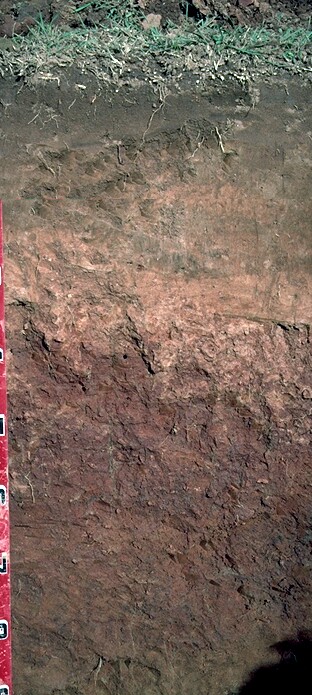GN29
| Australian Soil Classification: Haplic, Eutrophic, Red CHROMOSOL (medium loamy surface) | |
| Northcote Factual Key: Dr 2.33 | Great Soil Group: red-brown earth |
| Soil Type: SHEPPARTON FINE SANDY LOAM | |
| General Landscape Description: Level plain with prior stream activity. | |
| ||
Surface Soil
| A1 | 0-25 cm | Reddish brown (5YR4/4) fine sandy loam; pH 6.1; abrupt change to: |  GN29 Profile |
| A2 | 25-30 cm | Yellowish red (5YR4/6) sporadically bleached fine sandy loam; very firm consistence dry; pH 6.9; abrupt change to: | |
| Subsoil | |||
| B21 | 30-60 cm | Red (2.5YR4/8) fine sandy clay; some mixing with surface horizon material; weak to moderate coarse blocky structure; contains a trace (< 2%) amount of manganese stains; pH 7.1; clear change to: | |
| B22 | 60-85 cm | Red (2.5YR4/8) and dark red (2.5YR3/6) fine sandy clay loam; contains a few (2-5 %) manganese stains associated with root channels; pH 8.4; clear change to: | |
| B31 | 85-140 cm | Strong brown (7/5YR4/8) light fine sandy loam (micaceous); pH 8.3; clear change to: | |
| B32 | 140 cm+ | Pale brown (10YR6/3) [with yellowish brown (10YR5/4) associated with root channels] sandy loam (micaceous). | |
Key Profile Features:
- Moderate texture contrast between surface (A) horizons and upper subsoil (B21) horizon.
pH | Salinity Rating | |||
Surface soil (A1 horizon) | Slightly Acid | Very Low | Non-Sodic | None |
Upper subsoil (B21 horizon) | Slightly Alkaline | Very Low | Non-Sodic | Slight |
Deep subsoil (at 1 m) | Moderately Alkaline | Very Low | Non-Sodic | - |

Surface (A) Horizons
- The surface soil has a very high fine sand (54%) and silt (19%) content. Organic matter has a very important influence on soil aggregation in such soils and is also important in terms of fertility and water holding capacity.
- The relatively low wilting point value (6 %) indicates that plants will be better able to utilise light rains falling on relatively dry soil compared to the more heavier textured surface soils on nearby soil types.
- The nutrient status (based on the sum of the exchangeable basic cations) of the upper subsoil is low-moderate.
- The upper subsoil is non-sodic and has a reasonable calcium:magnesium ratio (ie. 1.6). Slight dispersion occurs but the soil should be relatively well drained.
Profile described by Mark Imhof and Paul Rampant (4/6/96)


